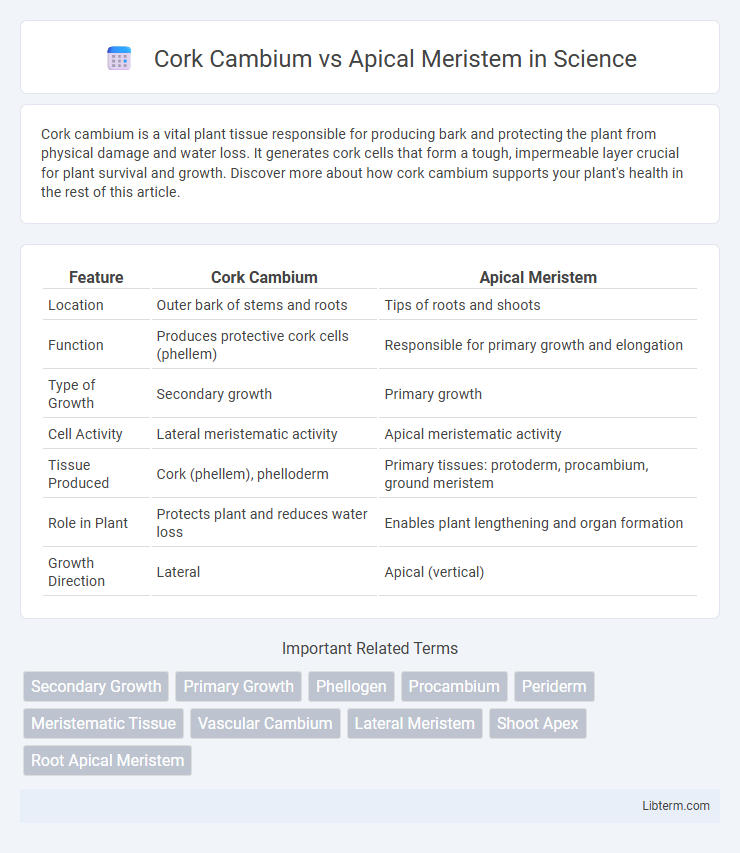Cork cambium is a vital plant tissue responsible for producing bark and protecting the plant from physical damage and water loss. It generates cork cells that form a tough, impermeable layer crucial for plant survival and growth. Discover more about how cork cambium supports your plant's health in the rest of this article.
Table of Comparison
| Feature | Cork Cambium | Apical Meristem |
|---|---|---|
| Location | Outer bark of stems and roots | Tips of roots and shoots |
| Function | Produces protective cork cells (phellem) | Responsible for primary growth and elongation |
| Type of Growth | Secondary growth | Primary growth |
| Cell Activity | Lateral meristematic activity | Apical meristematic activity |
| Tissue Produced | Cork (phellem), phelloderm | Primary tissues: protoderm, procambium, ground meristem |
| Role in Plant | Protects plant and reduces water loss | Enables plant lengthening and organ formation |
| Growth Direction | Lateral | Apical (vertical) |
Introduction to Plant Meristematic Tissues
Plant meristematic tissues comprise regions of undifferentiated cells responsible for growth and development, with cork cambium and apical meristem serving distinct functions. Cork cambium, a lateral meristem, contributes to secondary growth by producing protective outer layers like bark in woody plants. In contrast, the apical meristem, located at shoot and root tips, drives primary growth by elongating stems and roots through continuous cell division.
What is Cork Cambium?
Cork cambium is a lateral meristem responsible for producing the outer protective layer of bark in woody plants, generating cork cells that prevent water loss and protect against physical damage. Unlike the apical meristem, which drives primary growth by elongating shoots and roots, cork cambium contributes to secondary growth by thickening stems and roots. This tissue plays a crucial role in forming periderm, replacing the epidermis as the plant matures.
What is Apical Meristem?
Apical meristem is a region of actively dividing cells located at the tips of roots and shoots, responsible for primary growth and elongation in plants. Unlike cork cambium, which generates protective outer layers such as the periderm during secondary growth, the apical meristem produces new tissues that contribute to the plant's vertical extension. This meristematic tissue plays a critical role in forming fundamental structures such as leaves, flowers, and stems by continuously generating new cells.
Origin and Developmental Differences
Cork cambium originates from the cortex tissue in mature stems and roots, forming part of the lateral meristem responsible for secondary growth, producing protective outer bark cells. Apical meristem arises from the embryonic tissue at the tips of roots and shoots, driving primary growth by cell division and elongation to increase plant length. Developmentally, cork cambium activates during the secondary growth phase, while apical meristem remains active throughout the plant's life at growing tips.
Location in Plant Structures
Cork cambium is located in the periderm of stems and roots, responsible for producing the protective outer bark. Apical meristem is found at the tips of roots and shoots, driving primary growth by generating new cells for elongation. These distinct locations enable cork cambium to contribute to secondary growth while apical meristem supports primary growth in plant structures.
Functions of Cork Cambium
Cork cambium functions primarily in secondary growth by producing protective outer layers called cork cells that replace the epidermis in mature stems and roots. It generates suberin-rich cell walls that prevent water loss and protect the plant from mechanical damage and pathogens. Unlike the apical meristem, which is responsible for primary growth and elongation, cork cambium contributes to increasing girth and enhancing structural integrity.
Functions of Apical Meristem
Apical meristem is responsible for primary growth in plants, enabling elongation of roots and shoots by continuous cell division at the tips. It produces new cells that differentiate into various tissues, supporting the formation of leaves, flowers, and vascular components essential for nutrient transport. Unlike cork cambium, which contributes to secondary growth by generating protective bark layers, apical meristem drives the development of plant organs and increases overall height.
Anatomical and Cellular Characteristics
Cork cambium is a lateral meristem responsible for secondary growth, producing protective outer bark cells with thickened, suberized walls, while apical meristem is a primary meristem located at shoot and root tips, driving elongation by generating primary tissues. Cork cambium cells are more elongated and lignified, contributing to the formation of periderm, whereas apical meristem cells are small, densely packed, and mitotically active with thin primary cell walls. Anatomically, cork cambium forms a continuous cylindrical layer within the stem or root periphery, contrasting with the localized, dome-shaped apical meristem regions at organ tips.
Role in Plant Growth and Regeneration
Cork cambium is a lateral meristem responsible for secondary growth by producing the protective outer bark in woody plants, enhancing durability and defense against environmental stress. Apical meristem drives primary growth by generating new cells at the tips of roots and shoots, enabling elongation and the formation of leaves and flowers. Both contribute to regeneration, with apical meristems facilitating organ formation and cork cambium supporting tissue replacement and wound healing.
Key Differences Between Cork Cambium and Apical Meristem
Cork cambium is a lateral meristem responsible for secondary growth, producing cork cells that replace the epidermis and protect the stem, while the apical meristem is a primary meristem located at the tips of roots and shoots, driving vertical growth by generating primary tissues. Cork cambium forms secondary protective tissues, contributing to the thickening of stems and roots, whereas apical meristems initiate new organs such as leaves and flowers through cell division at plant extremities. Cork cambium activity occurs during secondary growth phases, contrasting with the continuous primary growth facilitated by apical meristems.
Cork Cambium Infographic

 libterm.com
libterm.com